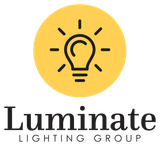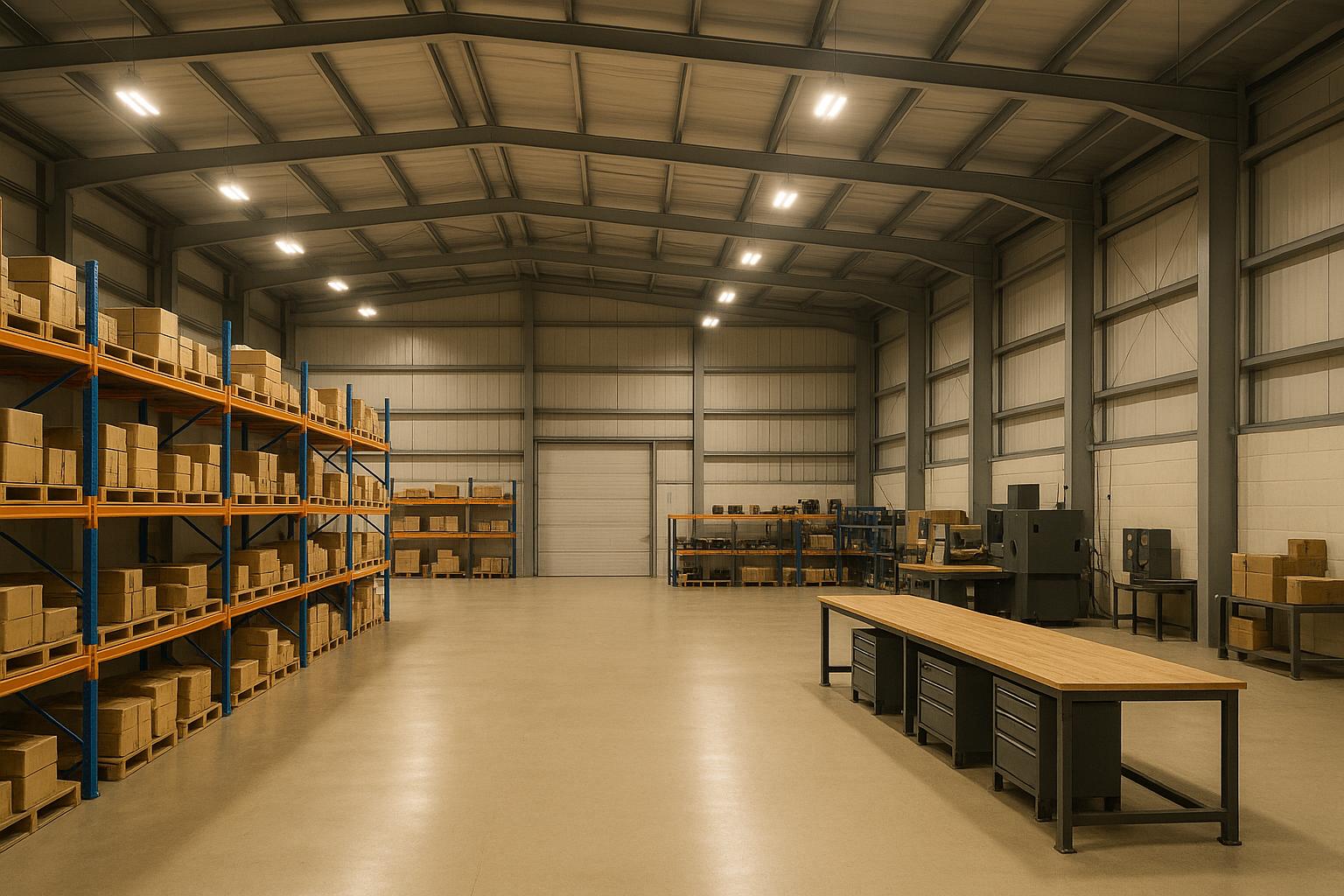Upgrading to industrial LED lighting offers significant energy savings, reduced maintenance costs, and quick payback periods, making it a smart financial choice.


Upgrading to industrial LED lighting is one of the smartest financial decisions for facilities. Why? Because it delivers 50–90% energy savings, slashes maintenance costs, and offers payback periods as short as 6–12 months. Here's what you should know:
Switching from legacy systems like metal halide or fluorescent fixtures eliminates high energy use, frequent maintenance, and missed rebate opportunities. Facilities upgrading to LEDs benefit from lower costs, better light quality, and a smaller carbon footprint.
For example, replacing 100 outdated fixtures with LEDs can save $7,175 annually on a $4,000 project, achieving payback in just 6.7 months. This makes LEDs a cost-effective, long-term solution for industrial lighting needs.
Switching to industrial LED lighting offers a strong financial case, thanks to energy savings, reduced maintenance costs, rebates, and quick payback periods.
LED retrofits in industrial settings can cut energy use by 50% to 90%. To calculate these savings, compare the wattage of your current lighting with the proposed LED system using this formula:
Energy Savings = (Current Power Consumption − LED Power Consumption) × Electricity Rate × Annual Operating Hours.
On top of cutting kilowatt-hour (kWh) consumption, LEDs generate significantly less heat than traditional lighting, leading to HVAC-related savings of 20% to 40%.
Maintenance savings often fly under the radar but are a key part of LED retrofit ROI. Unlike traditional lighting systems, which require frequent bulb replacements and labor, LEDs last 25,000 to over 50,000 hours. This longevity can reduce maintenance expenses by 15% to 25% of total savings. Facilities running 24/7 or using high-bay lighting systems benefit even more. For a full ROI calculation, maintenance savings should be added to energy savings and divided by the project’s net cost.
Utility rebates and tax incentives can cover 20% to 50% of the cost of an LED retrofit, making upgrades more affordable and improving ROI. Examples include federal tax deductions under Section 179D for energy-efficient commercial building upgrades and various state and local utility rebate programs. With rebate opportunities at an all-time high, now is an ideal time for industrial facilities to consider LED upgrades.
"Our team pre-qualifies rebates, completes the paperwork, and ensures timely reimbursement - accelerating payback and enhancing ROI." - Luminate Lighting Group
For example, if a $4,000 LED project qualifies for $1,000 in rebates, the net cost drops to $3,000, significantly increasing ROI and shortening the payback period.
Industrial LED retrofits generally pay for themselves within 6 months to 3 years, depending on specific factors like electricity rates, operating hours, and available rebates. The payback period is calculated by dividing the project’s total cost by its annual savings.
Several factors influence payback speed, including:
The ROI formula is:
ROI = (Total Annual Savings − Annual Finance Cost) ÷ Initial Investment × 100.
For a more detailed analysis, Net Present Value (NPV) models can factor in rising energy costs over time, offering a clearer picture of long-term benefits. Facilities with intensive energy use, extended hours, and access to rebates typically see the fastest returns. Adding smart controls can push savings past 90%, further shortening payback periods and maximizing overall returns.
These quick payback timelines set the stage for comparing LED performance against older systems in the next section.
Legacy lighting systems, such as metal halide and fluorescent fixtures, come with substantial energy and maintenance demands. These older systems can weigh heavily on industrial facilities' budgets, making it important to understand their costs when evaluating the financial advantages of switching to LED lighting. From high energy use to frequent maintenance, these systems create ongoing expenses that modern LED technology can significantly reduce.
Metal halide and fluorescent fixtures are notorious for their high energy consumption. A typical metal halide high bay fixture uses 400 watts or more, while fluorescent systems with T8 or T12 lamps consume between 96 and 192 watts per fixture, depending on the lamp and ballast configuration. This energy demand directly translates into higher utility bills and operational costs.
The inefficiency of these systems only worsens with time. Metal halide lamps, for instance, can lose up to 40% of their initial light output within their first year of use. To compensate for this rapid decline in brightness, facilities often over-light their spaces, further driving up energy consumption and costs.
Maintenance is another significant expense with legacy lighting systems. Metal halide and fluorescent fixtures typically require bulb replacements every 1 to 2 years, especially in industrial settings where lights operate for long hours or even 24/7.
The challenges don't stop there. In industrial environments, fixtures are often installed at considerable heights or in hard-to-reach locations. This setup necessitates specialized equipment and skilled personnel for routine maintenance, adding to labor costs, equipment rentals, and downtime. These recurring expenses make legacy systems a costly choice for facilities.
Financial incentives for legacy lighting systems have largely disappeared. While some utilities once offered rebates for upgrading fluorescent systems, most programs now focus on encouraging LED adoption. Facilities sticking with outdated lighting miss out on the generous rebates available for LED retrofits. For example, utility providers like Oncor currently offer significant incentives for switching to LEDs - opportunities that are entirely unavailable to those maintaining older systems.
Legacy lighting systems don’t provide a payback period; they simply generate ongoing costs. While it may seem cost-effective to maintain existing fixtures because there’s no upfront investment, this view ignores the mounting operational expenses. A closer look at the numbers reveals the true cost. For instance, replacing 100 metal halide fixtures with LEDs can save a facility $7,175 annually, based on $71.75 in reduced energy and maintenance costs per fixture per year. Legacy systems, by contrast, continue to incur these expenses indefinitely, offering no path to long-term savings.
| Feature | Metal Halide/Fluorescent | LED Lighting |
|---|---|---|
| Energy Efficiency | Low | High (50–80% savings) |
| Maintenance Frequency | High (1–2 years) | Low (10+ years) |
| Light Output Stability | Decreases rapidly | Stable over lifespan |
| Rebate Eligibility | Limited/declining | High |
| Payback Period | N/A (ongoing costs) | 1–3 years (typical) |
Additionally, legacy systems may fall short of meeting current energy codes and sustainability standards, which could lead to regulatory and operational challenges. These ongoing disadvantages highlight the strong financial and operational benefits of transitioning to LED technology.
Building on the earlier discussion about savings and payback periods, let’s dive into the key advantages and challenges of industrial LED lighting and legacy lighting systems. Understanding these factors can clarify how they impact costs and overall efficiency, helping facilities make smarter decisions.
Industrial LED lighting provides a strong financial edge thanks to significant energy savings and reduced maintenance needs. LEDs can slash energy use by 50–90% and last up to 100,000 hours, which translates to lower energy bills and fewer replacements. On the flip side, LEDs often come with a higher upfront cost and may face compatibility issues with existing fixtures or control systems.
Legacy lighting systems, like metal halide or fluorescent fixtures, are appealing for their lower initial costs - especially if they’re already installed. However, they bring higher ongoing expenses due to increased energy consumption and frequent maintenance. For instance, metal halide fixtures typically use around 400 watts, and their light output can drop by up to 40% in the first year. This forces facilities to over-light areas just to maintain adequate brightness. Additionally, these older systems rarely qualify for utility rebates, which can cover 20–50% of project costs when upgrading to LEDs.
| Aspect | Industrial LED Lighting | Legacy Systems (Metal Halide/Fluorescent) |
|---|---|---|
| Energy Efficiency | Cuts energy use by 50–90% | Much higher energy consumption |
| Maintenance | Lifespan of 50,000–100,000 hours | Lifespan of 10,000–30,000 hours |
| Upfront Investment | Higher initial cost | Lower cost if already installed |
| Financial Incentives | Eligible for rebates covering 20–50% of costs | Rarely eligible for rebates |
| Payback Period | 6–12 months with strong ROI | No clear payback period; high ongoing costs |
| Light Quality | Consistent output, instant-on performance | Degrades over time, requires warm-up |
| Environmental Impact | No mercury, lower emissions | May contain mercury, higher carbon footprint |
These factors play a significant role in determining the overall return on investment (ROI) for lighting upgrades. By weighing the pros and cons, facilities can make informed choices that balance initial costs with long-term benefits.
Switching to industrial LED lighting offers a clear financial edge over older systems. To recap, LED retrofits can slash energy use by 50–90% and cut maintenance expenses by 20–40% over their lifespan. With payback periods as short as 6–12 months and annual returns on investment (ROI) exceeding 76%, the numbers speak for themselves.
The financial benefits are hard to ignore. For instance, replacing 100 outdated fixtures with LEDs can save $7,175 annually. Add to that utility rebates, which can cover 20–50% of the project costs, and the long-lasting durability of LEDs, and the long-term value becomes even more compelling.
For businesses weighing the decision to upgrade, the timing couldn’t be better. Utility rebates for LED projects are at record highs, and advancements in LED efficiency and affordability make the savings potential even greater. Of course, actual savings depend on factors like facility conditions and usage patterns, which is why professional assessments are key to fine-tuning ROI estimates.
This is where experts like Luminate Lighting Group come in. Their comprehensive services - ranging from energy audits and custom designs to installation and handling rebate paperwork - simplify the process and ensure maximum financial benefits.
Among industrial investments, LED retrofits stand out for their fast payback and impressive returns, often outperforming other capital improvements. With proper planning and professional execution, businesses can quickly start reaping these rewards.
Utility rebates and tax incentives play a major role in boosting the return on investment (ROI) for industrial LED lighting upgrades. By lowering upfront costs and cutting down payback periods, these programs make energy-efficient projects more cost-effective and attractive.
Luminate Lighting Group simplifies this process by taking care of the heavy lifting. They identify which rebates you qualify for, handle all the paperwork, and ensure you receive reimbursements promptly. This hands-on approach ensures clients get the most savings possible while increasing the overall value of their lighting upgrades.
When calculating how long it will take to recoup the investment in LED lighting, there are a few critical factors to consider:
By weighing these factors, facilities can better gauge the return on their LED lighting investment and determine how quickly they'll see the benefits.
Switching to LED lighting isn't always a straightforward process. You might encounter hurdles like compatibility with your current fixtures, wiring, or control systems. However, these challenges can be effectively managed with proper planning and expert installation.
That’s where Luminate Lighting Group steps in. We offer comprehensive retrofit services, covering everything from custom lighting design and installation to handling permits. Our team of licensed electricians ensures that your new LED system integrates seamlessly, operates efficiently, and meets all required codes - keeping disruptions to your business at a minimum. Plus, we assist in securing utility rebates and tax incentives, helping you get the most out of your investment.